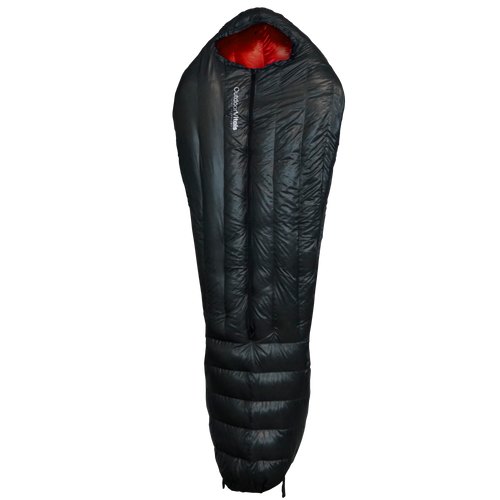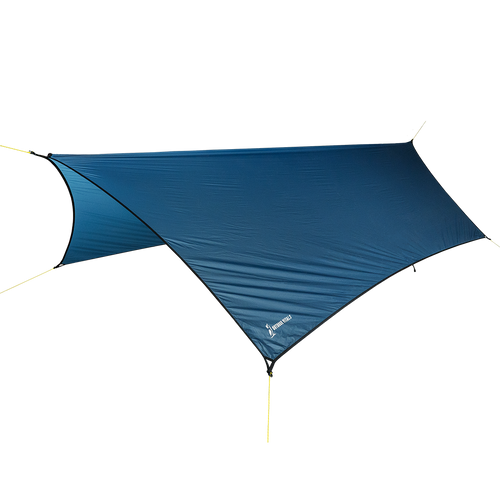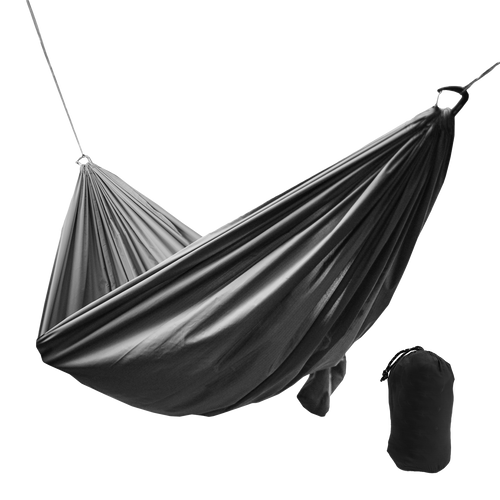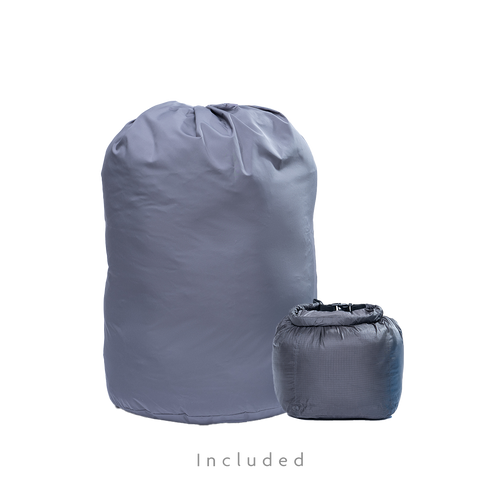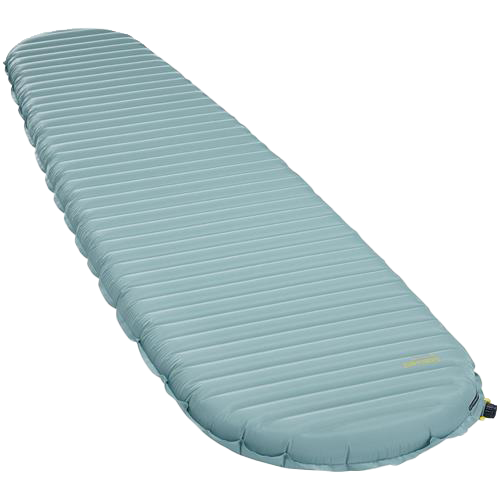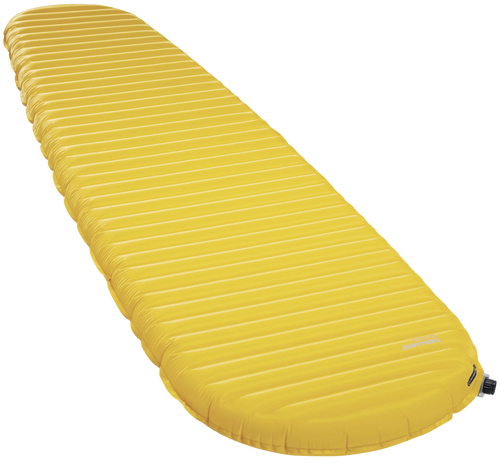Sleeping Bag Insulation: What's the difference?
As the outdoor gear industry continues to advance and new technologies are being introduced, it can be hard to know what exactly you should be looking for. One particularly important choice is what type of insulation to get in your sleeping bag or quilt. This article will help separate the different types of insulation and the aspects and features of each.
There are a couple different types of insulation on the market:
- Bonded insulation (synthetic): comes in sheets. Keeps insulation together and spread uniformly. Works when wet, is easier to take care of, cheaper, and a little more breathable and forgiving of extreme temperatures because it doesn’t need coating.
- Down insulation: warmest weight to warmth ratio. Very compressible, more maintenance involved, and can “wet out” or gets wet and collapses as insulation and doesn’t insulate. Even our StormLoft (DWR treated at the down level) has some risk of wetting out.
- Loose-Fill Synthetic insulation: tries to mimic down by being light and compressible, but is synthetic so still keeps the ability to insulate when wet.
Synthetic Insulation
StormLight™ at Outdoor Vitals is an example of bonded insulation. Bags using this type of insulation don’t need any kind of baffle system. Actually, having baffles would lower the performance of a bag using StormLight™ insulation because the seams of the baffles would let some cold air leak into the sleeping bag.
StormLight™ also insulates when wet. Our founder, Tayson, decided to give one of our 20 degree StormLight™ sleeping bags a “torture test” by getting the bag as wet as possible and then sleeping in it to see if it would still be warm.
First he tried to just lay it out on the patio and run water on it with a hose. After letting pools of water form on it, he opened up the sleeping bag and found it was still mostly dry on the inside. So he filled a tub with water and squeezed the air out of the bag and then put it in the water to suck moisture into it instead of air, much like a sponge. This type of soaking is really unrealistic and your bag is not likely to ever get that soaked in the outdoors, but we wanted to really test what this bag could do.
After sleeping in the bag all night, we found some surprising things. Tayson’s body heat actually pushed moisture out of the bag, and parts of him were dry through a lot of the night. His shoulders/head didn’t have enough body heat to push all the moisture out of the hood of the bag, but overall things dried out. The reason this happened and some of the bag dried out and Tayson was able to stay fairly warm was because all the fibers of the insulation are siliconized, so water doesn’t bond to them, but wicks away.
This experience demonstrates the perks of having a synthetic insulation like StormLight™ in your sleeping bag. Often in the outdoors there’s a threat of getting your gear wet, especially if there’s bad weather. A synthetic insulation can help ensure that you stay warm.
But there are drawbacks; bonded synthetic insulation can often be heavy and hard to compress. It will take up space in your pack and weigh you down.
Down Insulation
Down, on the other hand, is very light and compressible. Down has a much higher weight to warmth ratio, meaning for less weight, it can be a lot warmer than synthetic insulation. Down is a byproduct of the meat industry, so when they slaughter ducks or geese for meat, down is also harvested. Down is not the feathers, but the fluffy stuff beneath. One thing we value is making sure our down is RDS or responsibly sourced. Our down is taken from animals that are already being used for meat instead of taken from live pluckings.
Our down is IDFL (third party) certified. This certification has to do with the ratings. For example, down could be rated as 800 fill-power down. 800 fill-power down means that one ounce of down will fill 800 cubic inches of space. Lower quality down will fill less space. The reason that being IDFL certified is so important is that some companies claim they use certain fill power in their gear, but haven’t really tested it or are just totally off. A bag rated for 0 degrees might actually only be sufficient in 20 degrees if the rating is off. You want to make sure you are getting what you pay for.
 Outdoor Vitals offers a version of down we call StormLoft™. Why on earth would someone want to pay more money for StormLoft™ instead of just regular down? Let me inform you. StormLoft™ has been DWR treated at the down level, making it more water resistant. Down loses its insulating ability when it gets wet, so this is a great feature! Apart from the DWR treatment that the shell of our bags get, the down itself is also water resistant. Now, this does not make it completely waterproof, and it’s still possible to get “wetted out” and fail to insulate. But it will hold up better in damp or moist conditions than standard or regular down. Obviously being out in the woods wet and cold makes for a pretty rotten day.
Outdoor Vitals offers a version of down we call StormLoft™. Why on earth would someone want to pay more money for StormLoft™ instead of just regular down? Let me inform you. StormLoft™ has been DWR treated at the down level, making it more water resistant. Down loses its insulating ability when it gets wet, so this is a great feature! Apart from the DWR treatment that the shell of our bags get, the down itself is also water resistant. Now, this does not make it completely waterproof, and it’s still possible to get “wetted out” and fail to insulate. But it will hold up better in damp or moist conditions than standard or regular down. Obviously being out in the woods wet and cold makes for a pretty rotten day.
Where is the happy medium? Is there a product that can do the good things from both these types of insulation? That’s where loose-fill synthetics come in.
Loose-Fill Synthetics
There are a number of different types of loose-fill synthetics that are basically trying to mimic down. They’re lightweight and compressible, but they have pros of synthetic insulation (insulate when wet, affordable, breathable, etc.)
We’ve met with some of the most reputable insulation companies in the world to see what they have to offer. For a while didn’t find anything we quite liked. When there was something we were interested in, we would look at the gear companies that used that type of insulation and the products they made. After testing out some of these products we just weren’t quite satisfied with the performance of the insulation. Some insulations are a bit too clumpy, or have a variety of other issues.
A few months back, we came across a great company to work with and were able to produce what we call LoftTek™ insulation. LoftTek™ insulation is the closest thing to down insulation we have ever seen without actually being down. All the individual plumes look just like plumes from down, and are amazing in mimicking down, especially in what we’ve tested.
LoftTek™ insulation is a hollow-filament polyester fiber that’s about 2.5 denier, so it’s a very small fiber which also helps with its thermal efficiency. It’s actually been rated. We sent it in to the IDFL (International Down Laboratories for Testing), and they typically test down. However they tested our LoftTek™ as if it were down, and it rated as a 525 fill-power by them. Essentially LoftTek™ is rating as a little bit of a lower quality down, but retaining all the properties of a synthetic. The fibers have been siliconized so that as it comes in contact with water, the water won’t stick to it but kind of just drains out. This also makes it anti-static.
Why is the anti-static nature such a great thing? It makes the insulation more stable. One of the hardest parts of using a loose-fill synthetic insulation is stability. If it’s not stable enough, you have to sew it into tiny baffles, which brings in more opportunity for cold air to seep in on those baffles.
Here are some more pros of LoftTek™ insulation.
LoftTek™ is way more compressible than the bonded insulation. Those big sheets don’t compress down very well. It’s light like down, giving it a higher weight to warmth ratio than other synthetics. Unlike down, LoftTek™ remains warm when wet, and it dries a lot faster as well. It’s more breathable and doesn’t require down-proof coated fabric, which allows for more air movement. LoftTek™ is easier to wash and take care of than down.
Another pro for LoftTek™ is that it is not a byproduct of the meat industry. All of our down is responsibly sourced, meaning it is a byproduct of the meat industry and not acquired by live plucking, but LoftTek™ is completely synthetic and not related to the meat industry in any way.
Bonus: Hybrid Insulation
Hybrid insulation at Outdoor Vitals is a blend between high quality down and loose fill synthetic. It can be found in hybrid sleeping bags such as our Atlas LoftTek Hybrid Sleeping Bags. By blending a small amount of synthetic insulation with down, we've created a synergy that gives you the ultralight warmth of down with the moisture resistance of a full synthetic. Essentially, these hybrid sleeping bags can get wet, and will still stay lofted and keep you warm. The synthetic loose fill element of the insulation helps to stabilize the down and keep it from collapsing when moisture is introduced.
Using one of these hybrid sleeping bags, you can have confidence that at the end of any trip, you'll have a warm sleeping bag to crawl into. Even if the weather takes a turn for the worse or you fall into a river, the hybrid insulation won't completely collapse.
For more information about our hybrid sleeping bags or quilts, please contact us at support@outdoorvitals.com and our gear specialists would be happy to answer any questions.
Story Time:
Tayson was out hiking and testing out one of our jacket prototypes that uses LoftTek™ insulation. It’s as warm as a down jacket, and is lightweight and compactable. Most of the day the weather was sunny and warm and Tayson was just packing the jacket. However the weather suddenly changed while he was up on the mountain and it started hailing and snowing. Tayson threw on the jacket and found that it heats and insulates like a down jacket. It ended up being a blizzard up there so some of the jacket insulation got “wetted out”. However, despite being wet, Tayson remained warm inside the jacket. The blizzard stopped about 45 minutes before he got back to his vehicle. During those 45 minutes, Tayson’s body heat basically pushed the moisture out of the jacket and he was almost dry by the time he got back to the vehicle.
In this instance you can kind of see how LoftTek™ gives you the benefits of both a synthetic and down insulation. We are really excited about LoftTek™ and will be using it in some of our upcoming products we are developing. Stay tuned for more info on those.
There you have it, folks. That should cover pretty much what you need to know about insulation. Being informed about the circumstances, climate, and conditions on your planned adventures can help you know what kind of insulation will work best for you. See you on the trail!

